This post contains the final, fourth part of my headphone impressions from the 2014 Consumer Electronics Show in Las Vegas.
For part 1 of my impressions, featuring Klipsch, Phiaton, Westone, and others, see here.
For part 2, consisting of Audio-Technica, STAX, Beyerdynamic, and Polk Audio, see here.
For part 3, which includes Audiofly, Marshall Headphones, and Sennheiser, among others, see here.
Scosche
Scosche has refined their lineup this year, discontinuing their flagship BA-dynamic hybrid IEMs and focusing on four of their headphones – the RH1056 and RH1060 full-size headphones and the RH656 and brand new lobeDOPE on-ears.
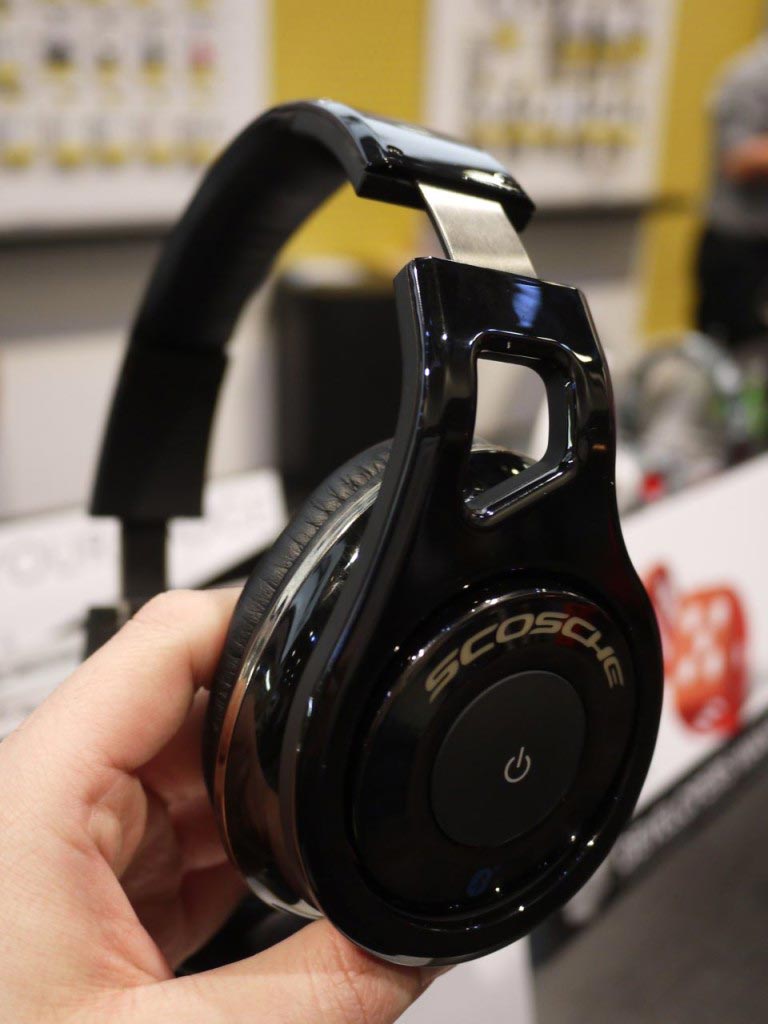
Scosche RH1060
The RH1060 is a full-size, Bluetooth, over-ear headphone priced at $200. It is the wireless version of the $150 RH1056MD, featuring Bluetooth 2.1 with AAC support. While it looks somewhat like a Beats clone, I have to say that the performance seemed quite reasonable for the price – plentiful, yet non-intrusive bass, good clarity, and nice, crisp treble. It’s a colored sound, but certainly not in a bad way, and it can be used wired as well as wirelessly.
When I asked about the headphones’ performance, the company rep stated that the RH1060 uses dual drivers with a crossover, “the first such setup in the world” (not my words). This statement is dubious at best and left something of a sour taste in my mouth – I could not find any supporting information online and even the manufacturer’s page just states that there is a 40mm dynamic driver in these headphones.
MSRP: $199.99 | Manufacturer’s page
Scosche RH600 and 656M
The RH600 is Scosche’s on-ear model, a solid-feeling little headphone with a metal frame. A version with mic and inline 3-button remote, the RH656, is also available. The headphone looks somewhat like a Beats Solo but at <$100 it is undoubtedly a better value. I also really liked the appearance of the RH656 in the Digital Camo pattern that Scosche had on display.

The same rep who claimed that the RH1060 has dual drivers also mentioned that all of the Scosche headphones use the same driver configuration, so it is possible that the RH600/RH656 use the same transducers as the RH1060/RH1056 and the differences in sound between them are down to the form factor.
I thought the on-ear model sounded more balanced compared to the full-size, giving up some of the RH1060’s bass depth for a tighter, more accurate low end. The mids seemed to be more in line with the rest of the sound as well, with a presence bump in the upper midrange and cooler overall tonal character. All in all, I thought the on-ears sounded very promising for the price and wouldn’t mind hearing them again.
MSRP: $89.99 – $99.99 | Manufacturer’s page
Scosche lobeDOPE
Said to use the same driver as the two sets above, this is the entry-level model and seems like it would have been a good value, but it simply didn’t fit me. I don’t think I have a particularly large head but unfortunately the cups would not seal with my ears. It might be a good one for kids, though, and it does seem sturdy and comes in lots of colors.
MSRP: $29.99 | Manufacturer’s page
MEElectronics
The meelec booth was divided into four sections after their four product lines, but the only headphones available for demo were the new Atlas on-ears. Also on display was the M-Duo IEM with dual dynamic drivers, but a demo set was not available.
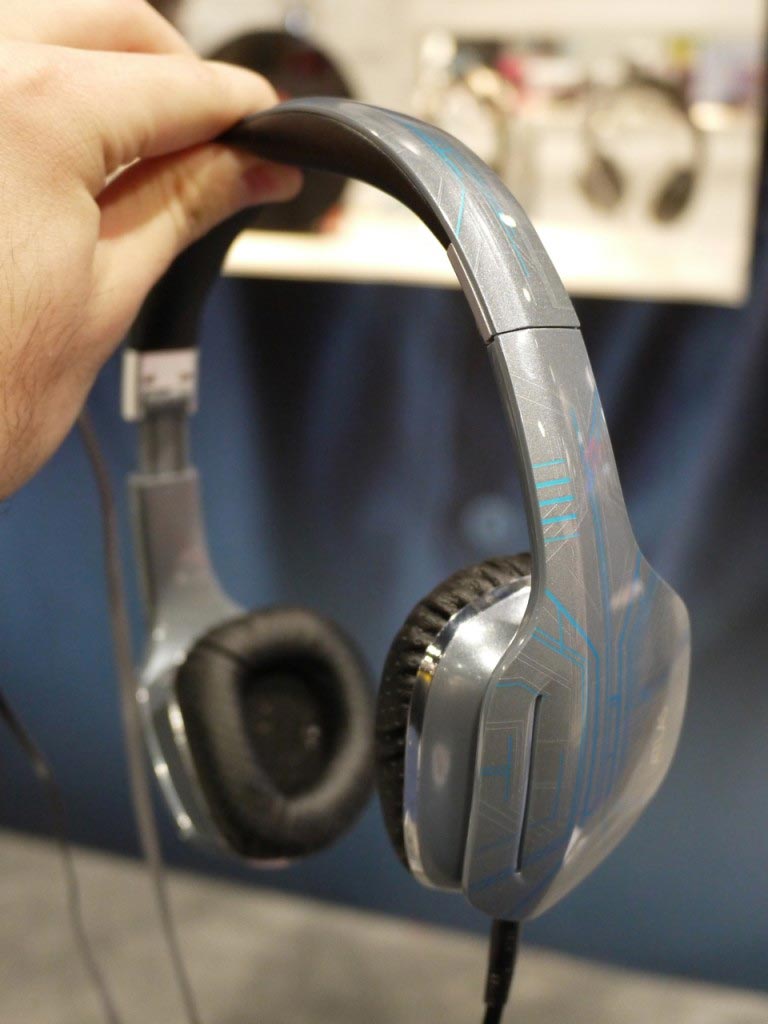
MEElectronics Atlas
Meelec’s new Atlas is a compact on-ear headphone with smooth lines and some rather unique designs, which are printed across the entire headphone through a process called “IML”. A couple of designs were on display but the one pictured is the Orion model. The construction of the headphone is mostly plastic but it has a metal band running through the headband. It seemed durable enough and is lightweight and quite comfortable. The cable is detachable with a conventional 3.5mm plug and comes with an inline mic, remote, and analog volume control.
I was told that the Atlas was tuned as an upgrade to the company’s popular M-series earphones (such as the M6 I recommended in the sub-$50 earphone buyer’s guide). Indeed I thought the sound was a little V-shaped, but in a good way, with deep but not bloated bass, good clarity, and crisp treble. Without the ability to compare directly I thought the Atlas sounded better than the other sub-$100 sets I tried at the show and was overall quite a nice set of headphones – lightweight and comfortable with some unique designs and impressive sound quality. Wouldn’t mind hearing them again in a quieter, sit-down setting.
MSRP: $99.99 | Manufacturer’s page
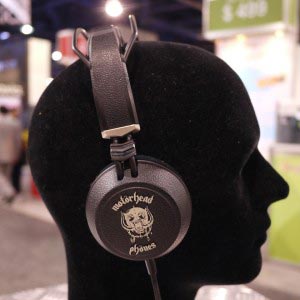
Motörheadphönes
I’m not ashamed to admit that I quite like Motörhead – Iron Fist is one of my favorite 80s metal albums and one of the few where every single track is worth a listen. I was rather excited to try the Motörheadphönes but the fact that I could hear the Motörhead booth before seeing it was a bad sign. Unfortunately the booth was set up to play a Motörhead concert, on a loop, at about 110dB through a bunch of speakers, so it was impossible to hear anything within a 30-foot radius of the headphone demo stand. Nonetheless, I tried the entry-level Bomber and flagship Motörizer headphones.
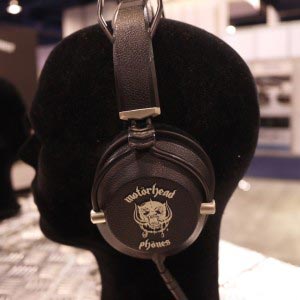
Motörheadphönes Bomber and Motörizer
All of the Motörheadphönes on display seemed quite well-made and not overly flashy. Both the Bomber and Motörizer utilize a split “floating”-style headband and the higher-end model has a breakaway cable a-la Superlux HD668B. The Motörizer lacked the polish and luxury feel of some of the other $130 headphones on the market, but then that makes sense as far the brand’s entire premise goes. I thought the Bomber and Motörizer both had ample bass and from what I could tell sounded at least average, but with the extreme noise level it was impossible to get a good read on them beyond that.
Bomber MSRP: $69.99 | Manufacturer’s page
Motörizer MSRP: $129.99| Manufacturer’s page
Nakamichi

The Nakamichi name is well-known to audiophiles – the Japanese company was deeply involved in Hi-Fi during the cassette deck era and was still developing amplifiers, receivers, and CD players in the 1990s. Towards the end of the decade, however, Nakamichi went bankrupt and was bought out by a Chinese holding company, which has since used the Nakamichi brand to market various consumer electronics. I have not had any experience with current Nakamichi products, but if the headphones they demoed at CES are any indication, I wouldn’t want to.
Nakamichi NK 600
 As usual I headed straight for the latest headphone release, which in the Nakamichi booth was the NK 600 model – a rather neat-looking on-ear with quilted earcups and headband. These headphones are available in a half-dozen striking colors and are rather well put-together but sounded so bad I had half a mind to walk two miles back to the STAX booth to recover. When it comes to audio quality these cans are muddy garbage and are absolutely unacceptable. I even tried two pairs to make sure the first one wasn’t defective. The MSRP wasn’t listed but whatever it is, the NK 600s are not worth the money and are the only headphones I thought worthy of a “Worst in Show” award. Avoid at all costs.
As usual I headed straight for the latest headphone release, which in the Nakamichi booth was the NK 600 model – a rather neat-looking on-ear with quilted earcups and headband. These headphones are available in a half-dozen striking colors and are rather well put-together but sounded so bad I had half a mind to walk two miles back to the STAX booth to recover. When it comes to audio quality these cans are muddy garbage and are absolutely unacceptable. I even tried two pairs to make sure the first one wasn’t defective. The MSRP wasn’t listed but whatever it is, the NK 600s are not worth the money and are the only headphones I thought worthy of a “Worst in Show” award. Avoid at all costs.
Ecko
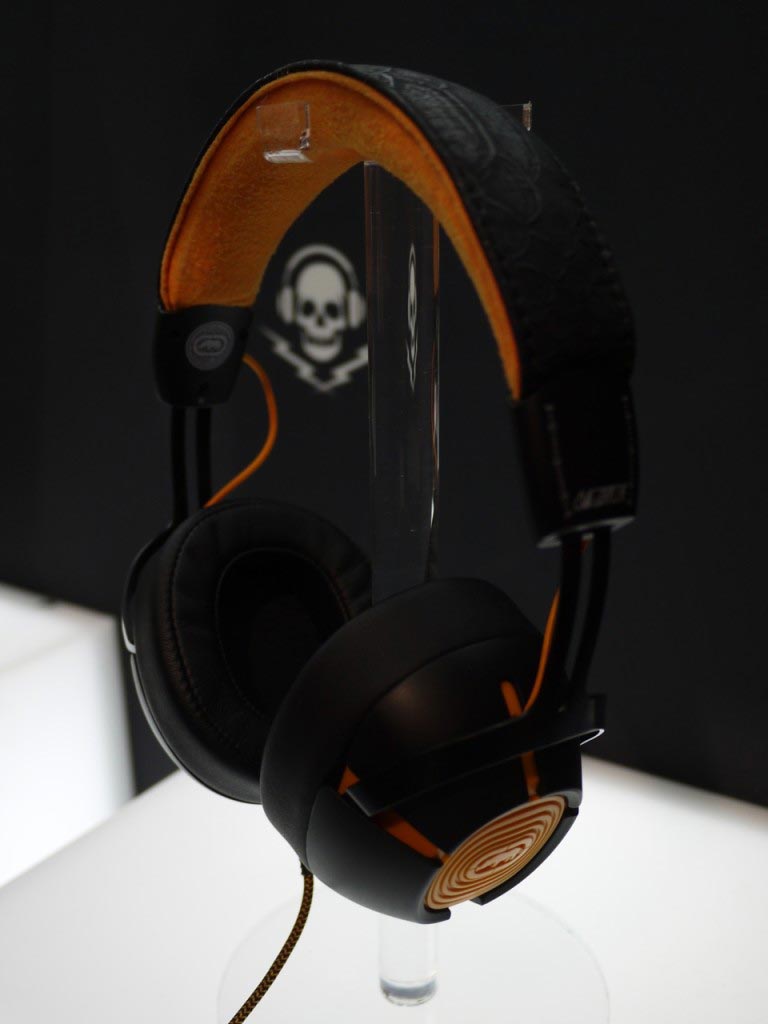
Ecko Unltd isn’t a company I think of when I think headphones, but the urban lifestyle brand has been selling audio accessories for a couple of years now as a subbrand of consumer electronics company Mizco International. Unfortunately no one was available to tell me about the company’s headphone products but I did try out their upcoming as-of-yet-unnamed full-size headphone.
Ecko Full-Size Headphones
I thought this retro-looking full-size can was the most interesting product in the Ecko booth. The headphones were quite heavy and had very deep earcups, reminding me of vintage 1970s sets on both counts. The deep cups sealed very well around the ear, providing both comfort and impressive passive noise isolation. There was still some background noise in the booth so it wasn’t easy to get a good read on the sound but I thought it was agreeable at least, with punchy but not bloated bass and decent clarity. The pricing of these new headphones is unclear but if they’re priced under $100 they may well be worth a closer look.
Razer
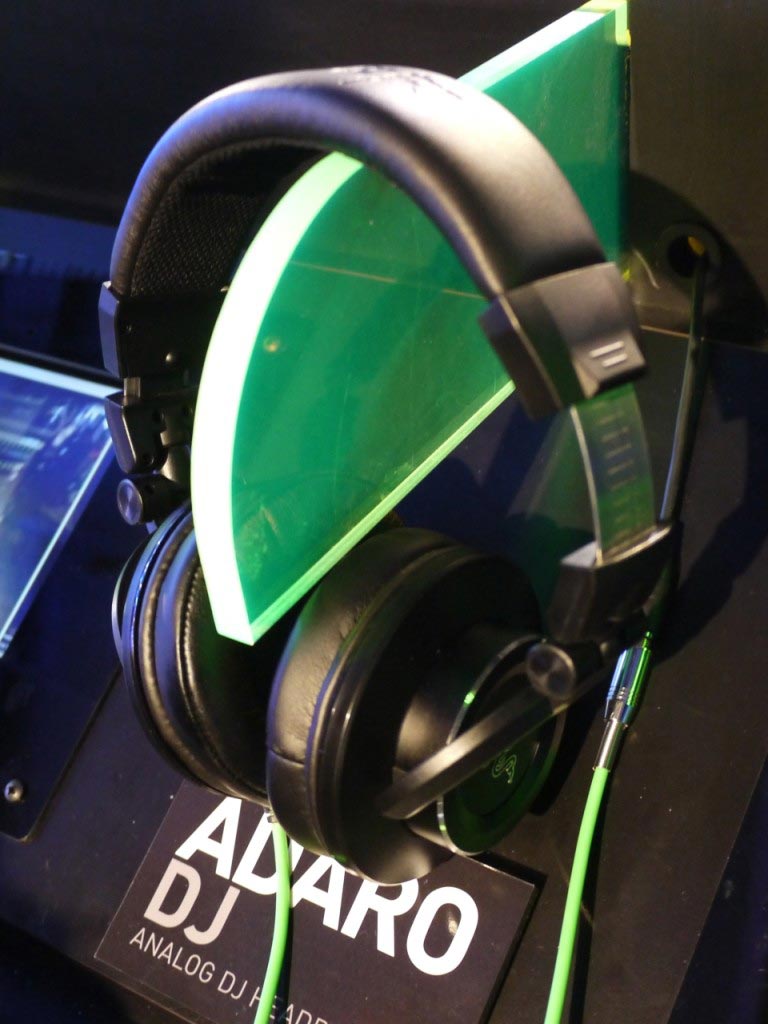
Since I got my hands on the fantastic Flux In-Ear and Flux In-Ear Pro from SteelSeries, I vowed never to dismiss gaming manufacturers as being able to make a great-sounding headphone. Razer’s Adaro headphone line, announced earlier this month, is said to be designed for music and on paper seems quite impressive. While I was more interested in the Adaro IEMs, they were locked under glass and instead I got a chance to try the upcoming Adaro DJ headphones.
Razer Adaro DJ
The Adaro DJ felt solidly built, if a little plain in terms of design. The construction is mostly metal and almost entirely black, though the characteristically (for Razer) green cable provides a much-needed color accent. The cable is detachable and like most other DJ headphones the Adaro DJ folds up.
The $200 price tag puts the Adaro DJ in competition with many great DJ headphones, including the ever-popular Audio-Technica M50 (and upcoming M50X) and one of my personal favorites, the Denon DN-HP700. Unfortunately the ambient noise level in Razer’s booth was second only to that of Motörheadphönes but the DJ headphones sounded pretty good – certainly not overly bassy and not at all muddy (towards the end of the show I had started to develop a PTSD-like fear of muddy headphones). It seems that like SteelSeries, Razer is serious about developing music products and the new Adaro line is at the very least worth a fair shot.
MSRP: $199.99 | Manufacturer’s page
German Maestro
Headquartered in Obrigheim, German Maestro (Sometimes stylized as GermanMAESTRO) is an audio component manufacturer closely related to German MB Quart, a company which no longer markets headphones. The German Maestro name is not one I see mentioned often on Head-Fi and I’ve never really had a close look at their lineup, but I made a point to visit their booth, which was tucked away near a bunch of car audio manufacturers. It turns out they have more than half-dozen different headphones, all of which are designed with both sound quality and longevity in mind. By the time I got the German Maestro booth it was quite late and my camera had run out of batteries so no pictures, unfortunately.
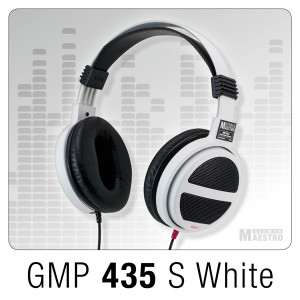
German Maestro GMP 435 S White
This model is the latest release from German Maestro, a more stylish white version of the GMP 435 S. It is a full-size, open-back headphone with a very lightweight construction. It may feel a little light and plasticky for a $320 headphone, but as with all things German Maestro was designed for durability, which the German Maestro rep demonstrated by twisting the headband into a pretzel. It doesn’t hurt how few moving parts there are to the structure – these headphones will almost certainly last for a very long time. Comfort was good thanks to the low weight of the headphones, as well as the dual headband and large internal diameter of the earpads.
 With its 35Ω impedance, the 435 S is marketed as being equally comfortable driven by an iPod while on the go and by a Hi-Fi system at home. Not sure how many people use full-size, open-back headphones on the go but these sounded good out of my Cowon J3 – clear and balanced, with a very slight bass boost, which is most likely there to make them usable on the go. I thought the bass was very clean and had good punch, and the overall clarity put these above the two other German Maestro models I tried. I feel these can go toe-to-toe with some of the most popular cans in that price range and would love to hear them again someday.
With its 35Ω impedance, the 435 S is marketed as being equally comfortable driven by an iPod while on the go and by a Hi-Fi system at home. Not sure how many people use full-size, open-back headphones on the go but these sounded good out of my Cowon J3 – clear and balanced, with a very slight bass boost, which is most likely there to make them usable on the go. I thought the bass was very clean and had good punch, and the overall clarity put these above the two other German Maestro models I tried. I feel these can go toe-to-toe with some of the most popular cans in that price range and would love to hear them again someday.
MSRP: $319.99 | Manufacturer’s page
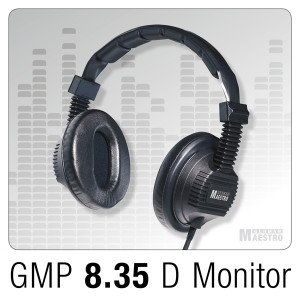
German Maestro GMP 8.35d Monitor
I also tried the classic GMP 8.35d Monitor, which was bassier but not quite as clear as the 435 S. This model, in its various incarnations under the MB Quart and DBI International brands, is fairly well-known as a great option for high wear-and-tear applications, such as music demo stands. I was invited to drop it on the concrete floor to test the durability but there is no need – every part of these headphones is clearly built to last.
The DBI Pro700 is a very similar-looking headphone that I’ve tried in the past but according to German Maestro the audio performance differs from the GMP model. I liked the Pro 700, and I liked the GMP 8.35d as well, though it sounded a little less clear and more congested than the open-back GMP 435 S model I tried right before.
MSRP: $249.99 | Manufacturer’s page

German Maestro GMP 160
This portable model reminds me of a 1980s Sennheiser set and is German Maestro’s least expensive offering. It’s been a while since I last came across an open-backed portable headphone – these days they are quite rare and seemingly not very popular aside from a few classics like the Sennheiser PX100 and Koss PortaPro. Over-ear ones are rarer still but the GMP 160 certainly is everything I love about open portables – an incredibly lightweight set with low-profile circumaural earcups. I was amazed by their design – the driver chamber is only a millimeter or two thicker than the driver itself, which allows for rather deep and very comfortable earcups that beat many full-size headphones in internal volume.
In addition to the light weight and great overall comfort, I like the somewhat simplistic but durable design of the GMP 160. In terms of sound the portables offer up enhanced bass, though it doesn’t extend very far down. They are somewhat veiled-sounding, especially next to the GMP 435 S, but overall not bad consider the moderate price tag.
MSRP: $119.99 | Manufacturer’s page
That’s it for the fourth and final round of our CES 2014 headphone coverage. Keep an eye out for a summary post in the near future!



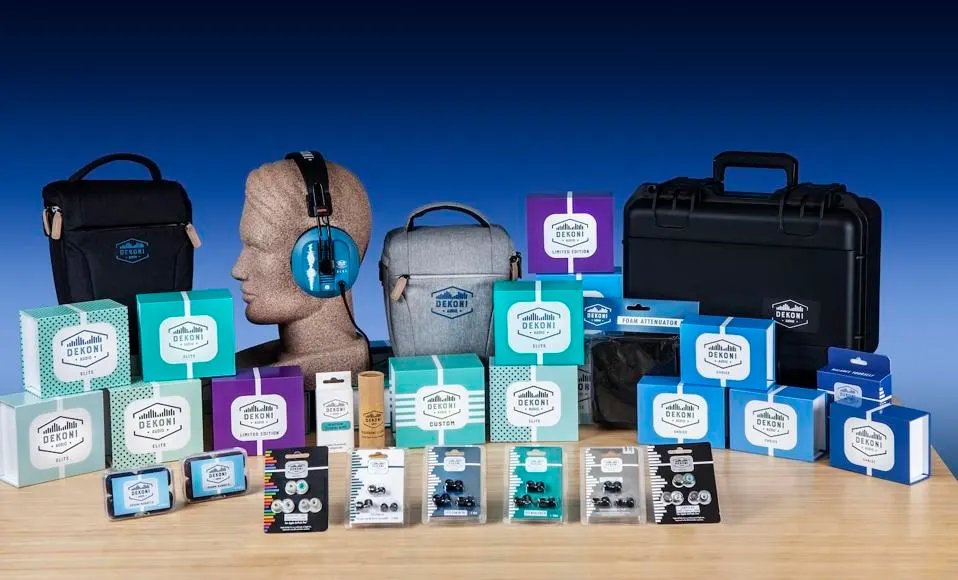
One Response
Great article.